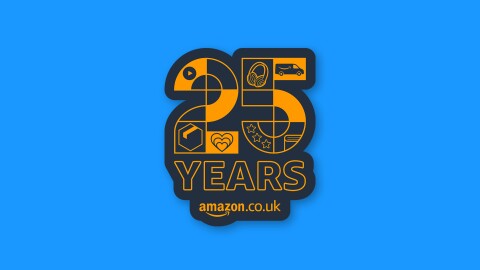The shift required to transition an established organisation into a digital powerhouse is challenging at best. Pressure for digital transformation is growing exponentially within organisations, as leaders across the commercial and public sectors react to an acceleration in expectations, deadlines and targets never before experienced.
To help leaders share and learn from one another as they face these challenges, Amazon Web Services (AWS) has launched the new AWS ExecLeaders hub – bringing unique insights on key topics to leaders across all sectors. Check out the hub to find a host of free resources for leaders, including videos, keynotes, case studies, events and more.
On June 9 and 10, the AWS Summit Online will also bring technologists together from across Europe, Middle East and Africa (EMEA) to connect, collaborate and learn about AWS. This free, two-day event will include keynotes from local industry leaders, educational sessions, hands-on labs and one-to-one chats with AWS experts. Register today to find out more.
To kick things off, Jonathan Allen, Director, Enterprise Strategy and Evangelist for AWS, shares his key insights about the demand on leaders for digital transformation – and how to remain focused on the end game.
What kind of challenge does digital transformation present to an organisation?
Transitioning a complex and long-established organisation from traditional to digital infrastructure can be hugely challenging. At worst, a faulty approach to digital transformation can lead an organisation down the same well-documented paths as brands like Kodak and Blockbuster, which famously failed to react to changing customer needs caused by the impact of technology.

The emergence of new ‘general purpose technologies’ (GPTs) like automation, artificial intelligence and machine learning might seem daunting for anybody running a major organisation, with jobs, shareholder value, profitability and much more on the line.
The reality is that we have been reacting to and benefiting from emergent GPTs for thousands of years – and digital technology is no different. Waves of innovation throughout history show our remarkable ingenuity and adaptability: from the revolutionary Bronze Age invention of the axle, allowing the wheel to defeat friction, through to the Industrial Revolution, Information Age and Digital Age.
Developments like steam power and electrified manufacturing created new possibilities through incremental improvement – small percentages of improved efficiency and productivity. Until recently, an organisation seeking to improve efficiency through digital technology might have required siloed, in-house teams with ‘hard’ knowledge of physical infrastructure, home-spun software and tools, and a methodology to build and rollout at scale. Companies were even building and managing their own individual data centres.
In early 2000, Amazon was facing a similar situation. The business was duplicating efforts in its tech infrastructure, which slowed down its ability to innovate for customers. We went on to develop a methodology that would remove the undifferentiated heavy lifting and unlock the many new possibilities of digital transformation.
How do we keep our organisations focused on strategic goals?
When I talk to CEOs, digital transformation is a common pain point. Usually, the conversation starts with a key question: are you optimized for agility or efficiency? And the answer is often ‘neither’.
Everybody understands that there has been a significant change over the last decade and recognises that operating models need to change continually. This is not just about adapting from technology A to technology B – it’s about preparing the organisation to adapt to new GPTs throughout its lifetime.
In my experience, CEOs are typically some of the most empathetic folks in the room. Leadership requires phenomenal emotional intelligence. They have to recruit and retain teams that the board can buy into, who have a mix of technical, financial and operational acumen. On this journey, they are always looking for shared lessons learned in order to save time and money.
This means our mindset, skills and tools must rapidly evolve to survive in the modern world. Whether you’re a business leader or an employee, it’s always a challenge to spot trends, focus on next steps, and work towards change. We all share an innate desire for stability – but change is constant.
By leveraging GPTs like the cloud, and understanding that you no longer need to do the things you used to and that you can remove the undifferentiated heavy lifting from your business, small, business-outcome teams are best-placed to focus on what really matters – solving problems and innovating on behalf of their customers. They do this by focusing on four key areas:
- Business logic
- Data (including deriving intelligence from data using machine learning)
- Interfaces (whether they are programmatic or human)
- Security and operational efficiency
By focusing on these key areas, organisations can cut out the noise and obsess over the opportunity.
Monzo Bank is a great example of this focus in action. Monzo has grown from an idea to a fully regulated bank on the AWS Cloud, and runs more than 1,500 core banking microservices on AWS. The UK challenger bank has millions of customers – but they do only offer an emergency website for customer service in case users have lost their phone. The bank is focused on its mobile app to deliver the primary experience, service, speed and convenience. Diluting their focus could detract from the customer experience, and Monzo’s target customer has already moved away from both the high street and website-based banking.
Why do some organisations transform faster than others?
There are four critical success factors for effective transformation at speed, and they illustrate why some organisations transform faster than others.
Firstly, executive engagement about why the organisation needs to change is vital. Does the organisation understand why it needs to change and is everybody on board?
Morrisons, one of the United Kingdom’s largest supermarkets, is a good example of this. They wanted to update their contact centre and sought a faster, more cost-effective, and more flexible alternative than its legacy system could offer—one that would give the company the operational autonomy to better serve its 11 million weekly customers.
The supermarket chain migrated to Amazon Connect, a cloud-based, omnichannel contact centre tool capable of automated interactions. In just eight weeks, the Morrisons team engineered and implemented an agile, scalable solution that enabled the company to deliver a new customer experience and become operationally self-sufficient. And they were able to do this in weeks rather than years because everyone understood the need for change.
Talented individuals on your team are the second critical success factor. All businesses are trying to recruit highly skilled people, but they often overlook their current employees. I believe that the people you need are the people you already have – they just need to be shown a path through change, and what their role can be.
Motivation is a vital consideration here – when we approach employees to change, we’re challenging their innate desire for stability. Humility is invaluable when seeking to comprehensively reskill folks at the coalface of your business systems.
We want to focus on new working styles, flexibility and autonomy, so we can build a brilliant team, provide guardrails, remove any blockers on their time, and then get out of their way. Conversely, teams operating with gates rather than guardrails can be costly and can become quickly demotivated. To optimise for speed, identify where lost or blocked time is occurring and do everything possible to remove those blockers. This helps to build an environment where your teams can invent and build in perpetuity.
Thirdly, look at the levers of control on business functions – particularly in highly regulated industries. Even with small, specialised teams, you will likely still require segregation of duty to effect change. If we want teams to invent, build, develop and support each other, they need to work within an appropriate system of control. In simple terms: the better the brakes (controls), the faster you can go.
Finally, the organisation needs to build its ‘migration muscle’. In digital transformation, we should understand that breaking away from traditional infrastructure requires longer-term focus from the leadership team and continued investment. This goes hand-in-hand with enabling the team you have to reskill, so they understand how leveraging cloud tools can allow them to focus on what really matters.
How do we optimise for speed whilst transforming at scale?
By adopting cloud technology, organisations are best placed to optimise for speed and transform at scale.
Speed is crucial – the time it takes to develop and launch a new product or service can be the difference between success and failure. Moving slowly might mean your global competition gets there first, your customer moves on, or the development and rollout phase takes so long that it is no longer cost-effective.
As more organisations move to the cloud, cost is becoming replaced by agility as a priority – the ability to innovate and move quickly with new products presents many more opportunities for profitability compared to trimming budgets elsewhere.
This urgency is driven in part by disruptive start-ups. The purpose of a start-up is to innovate quickly – they cannot necessarily afford development cycles of a year or more – and they must react in real time to feedback from customers. Monzo Bank, for example, avoids costly, heavyweight infrastructure investments in favour of efficient, scalable, secure and pay-as-you-go building blocks.
Scale and speed are just two reasons why the cloud is transforming industries, from financial services to automotive, travel, retail and beyond. This is perhaps the most fascinating aspect of cloud technology and digital transformation – it fosters innovation, enables agility, and drives change at remarkable new speeds.
AWS provides a portfolio of more than 200 fully featured services, from basic server storage to artificial intelligence and IoT tools, meaning organisations can quickly and easily access the building blocks for innovation – without heavy lifting, and with less time spent developing tools or software from scratch.
I hope the potential of cloud technology excites leadership teams – and if it sounds daunting, remember that our concept of productivity, how we measure ‘work done’, has always been about maximising time to value. This was as true about the invention of the wheel and steam power as it is about cloud technology today.
Find out more about AWS ExecLeaders and register today for AWS Summit Online EMEA.











